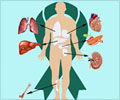When a transplant patient suffers complications such as graft rejection or graft-versus-host disease, physicians attempt to stop the body's immune response by targeting a patient's T cells
When a transplant patient suffers complications such as graft rejection or graft-versus-host disease, physicians attempt to stop the body's immune response by targeting a patient's T cells.
In a new study, University of Illinois at Chicago College of Medicine researchers suggest there may be a way to prevent these complications before they occur. The study was published July 1 in the journal Blood.Previous studies by these researchers found that T cells are stimulated by blood stem cells -- immature cells that have yet to differentiate into the various cell types of the blood.
In the new study, the researchers report finding unexpected two-way communication and stimulation between blood stem cells and T cells.
In laboratory and animal models, the UIC researchers showed that alloreactive T cells change the fate of blood stem cells and may themselves stimulate a strong immune response.
"Knowing what mechanisms cause this change in stem cells would allow us to test immunosuppressive drugs and different T cell subsets, potentially preventing or reducing graft-versus-host disease or rejection," said Dr. Damiano Rondelli, associate professor of hematology at UIC and lead author of the study.
Graft-versus-host disease occurs when white blood cells from the donor attack tissues of the recipient. It is a very serious complication after stem cell transplantation from related or unrelated donors and may represent a cause of death in 30 to 50 percent of patients.
Advertisement
Rondelli suggests that a loop occurs between stem cells and the donor T cells, causing them to grow and become immune-stimulating cells, called antigen-presenting cells. These new cells stimulate more T cells, and they recruit new stem cells to become more antigen-presenting cells. The more they activate each other, the more the T cell response grows.
Advertisement
(Source: Newswise)











